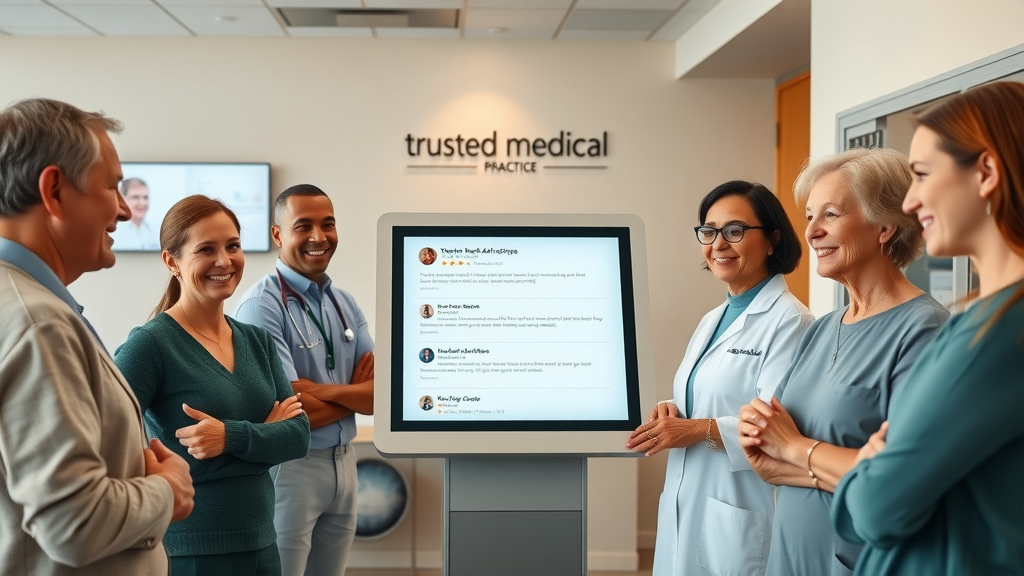Did you know that over 77% of patients now research healthcare providers online before ever making an appointment? This digital revolution has completely rewritten the rules of patient acquisition, enabling practices and healthcare organizations to thrive or risk being left behind.
In this comprehensive guide, you’ll uncover how patient acquisition digital marketing transforms the way healthcare providers build their patient base, optimize acquisition strategies, and deliver outstanding patient experiences.
Unveiling the Power: Why Patient Acquisition Digital Marketing Matters More Than Ever
In the past, healthcare marketing was built on word-of-mouth, print ads, and a patient’s proximity to a care provider. But today, as patients turn to digital touchpoints to research and select healthcare services, patient acquisition digital marketing has become the catalyst for sustained practice growth. Healthcare organizations that invest in rich digital marketing strategies are seeing transformative results, from increased appointment bookings to enhanced patient loyalty.
The shift toward a digital-first acquisition strategy isn’t just a trend; it’s a competitive necessity. Digital marketing harnesses data-driven campaigns, social media channels, and content that speaks directly to the needs of prospective patients. For providers, the opportunity to reach their ideal patient base with personalized, relevant messaging has never been greater. Or more critical.
Effective patient acquisition now relies on leveraging digital platforms for maximum visibility and engagement, equipping care providers with the tools to optimize every phase of the patient journey.
Are you ready to see how these strategies can future-proof your medical practice?

The Fundamentals of Patient Acquisition Digital Marketing
At its core, patient acquisition digital marketing is a strategic approach combining multiple online tactics to help healthcare providers attract and retain patients. The cornerstone elements include a user-friendly website, a compelling online presence, targeted advertising campaigns, and ongoing engagement through helpful content and outreach. Each of these building blocks must be tailored to appeal to your desired patient base and differentiate your practice in a crowded marketplace.
For care providers looking to develop sustainable acquisition strategies, it’s critical to harness analytics for tracking progress and optimizing marketing efforts. Regularly monitoring website traffic, online reviews, and prospect engagement helps practices adjust their approach, ensuring the acquisition strategy remains relevant and effective. Integrating digital marketing holistically, from SEO to social media engagement, establishes a consistent brand voice and reliable pipeline for potential patients.
Let’s see how digital outshines traditional methods:
Comparison of Traditional vs. Digital Marketing Strategies for Patient Acquisition | ||
Aspect |
Traditional Marketing |
Digital Marketing |
|---|---|---|
Reach |
Local, limited |
Global, scalable |
Targeting |
General mass audience |
Highly targeted (by demographic, behavior, interest) |
Measurement |
Difficult to track accurately |
Real-time analytics, measurable ROI |
Cost Efficiency |
Expensive and static |
Cost-effective, adaptable |
Engagement |
One-way (ads, flyers) |
Two-way (comments, reviews, messaging) |

How to Build a Winning Patient Acquisition Strategy Using Digital Marketing
The foundation of an effective patient acquisition strategy is knowing what you want to achieve—and how you’ll get there. Successful healthcare providers start by setting clear objectives: Do you want to increase new patient appointments by 20% in the next year? Or perhaps improve your online reviews to boost patient trust? By defining smart, measurable goals, providers can guide their digital marketing investments and efforts efficiently.
To develop an acquisition strategy that drives results, healthcare organizations need to focus on multi-touch marketing. That means creating a seamless patient journey across every digital touchpoint—from initial Google searches to appointment reminder emails. The best strategies align acquisition tactics with retention efforts, understanding that delivering an outstanding patient experience transforms new visitors into loyal patients and passionate advocates for your services.
Step-by-Step Process for Effective Patient Acquisition Digital Marketing
Identify your ideal patient base: Analyze demographics and health needs to target those most likely to benefit from your services.
Optimize your online presence: Ensure your website and profiles communicate expertise, trustworthiness, and convenience.
Leverage data-driven decision-making for your acquisition strategy: Use analytics to fine-tune your marketing campaigns and maximize ROI.
Enhance patient experience to boost retention: Engage patients with follow-up care, personalized content, and seamless digital tools.
“Digital marketing is the front door to modern patient acquisition—those who fail to invest are left behind.”
Maximizing Social Media for Patient Acquisition Digital Marketing
From Facebook and Instagram to LinkedIn and TikTok, have become vital channels for connecting with prospective patients. These platforms not only offer vast reach but powerful targeting capabilities, letting healthcare providers and medical practices engage specific segments based on age, interests, location, and more. Social media also makes it easy to humanize your healthcare brand, providing glimpses into your facility, team, and patient outcomes.
Targeted social media campaigns provide real-time opportunities to educate, inspire, and engage your community. Running campaigns that highlight preventive care tips, showcase patient success stories, or introduce new healthcare services invites interaction and builds trust. For medical practices, responding promptly to questions and comments shows patients you care—making it far more likely for patients to choose your practice over a less-engaged competitor.

Enhancing Online Presence and Reputation Management
Your online presence serves as the digital front door to your practice. Optimizing your website for speed, security, and mobile responsiveness is an important first step in converting site visitors into new patients. Claiming and fully optimizing your Google My Business profile ensures your practice appears in local search results—a must for any patient acquisition strategy.
Online reviews have emerged as a powerful influencer in the decision-making process. Positive patient testimonials and high-star ratings on sites like Google, Healthgrades, and Yelp boost your credibility and improve local search rankings. Encourage loyal patients to share their experiences, and address negative patient reviews with empathy and solutions. Building a library of video and written testimonials not only enhances trust but also gives prospective patients a sense of the patient experience your team delivers.

Content Marketing and SEO: The Cornerstones of Patient Acquisition Digital Marketing Success
Informative, patient-centered content is one of the most effective ways to attract, inform, and convert prospective patients. Educational blogs and guides addressing common concerns—such as “How to Choose the Right Care Provider” or “What to Expect During Your First Visit”—position your healthcare practice as a trusted authority. Compelling, easy-to-understand content helps demystify procedures, reduce anxiety, and encourage patients to take action.
Visual assets, like infographics and explainer videos, capture and maintain attention, making complex topics more accessible. For care providers and medical practices, these assets can illustrate the patient journey or highlight the benefits of specific healthcare services. Meanwhile, implementing strong SEO strategies —such as optimizing title tags, building backlinks, and including keywords like patient acquisition strategies and medical practice growth—ensures your content is discoverable to patients in your area searching for solutions.

Patient Experience and Retention: Sustaining Growth with Patient Acquisition Digital Marketing
Acquiring new patients is only the first step—retaining them ensures lasting success for your healthcare organization. Today’s patients expect frictionless digital engagement, from easy online appointment scheduling to automated reminders and personalized follow-up messages. By streamlining these digital touchpoints, care providers can create a memorable and positive patient experience with every interaction.
Retaining patients hinges on nurturing the relationship—via educational resources, timely check-ins, and responsive communication. Loyalty programs or automated newsletters keep your brand top-of-mind, while feedback surveys invite patients to share suggestions for improvement. Providers who invest in digital engagement consistently outperform those who treat patient acquisition as a one-time transaction, ultimately fostering a stable, loyal patient base.
“A patient acquired is only as valuable as the relationship you build after acquisition.”

Measuring Success: KPIs and Metrics for Patient Acquisition Digital Marketing
Conversion rate from patient acquisition campaigns: Measures the percentage of prospects who become patients.
Cost per acquisition for healthcare providers: Tracks how much you spend to gain each new patient.
Patient lifetime value and retention metrics: Analyzes the total value generated by retaining patients over time.
Common KPIs for Measuring Patient Acquisition Digital Marketing Performance | ||
KPI |
What It Measures |
Why It Matters |
|---|---|---|
Conversion Rate |
Site visitors/actions to appointment bookings |
Reveals the effectiveness of your campaigns and user journey |
Cost per Acquisition (CPA) |
Avg. marketing spend per new patient acquired |
Guides resource allocation and budget optimization |
Patient Lifetime Value (LTV) |
Total projected revenue from each patient |
Helps forecast ROI and future growth potential |
Retention Rate |
Percentage of patients who return |
Indicates loyalty and effectiveness of patient experience |
Referral Rate |
Number of new patients from recommendations |
Shows the impact of reputation and word-of-mouth |

Challenges Facing Healthcare Providers in Patient Acquisition Digital Marketing
Despite its many advantages, patient acquisition digital marketing is not without its hurdles. Healthcare providers face strict regulatory requirements—such as HIPAA in the United States—that mandate careful handling of patient information online. In addition, maintaining patient privacy while implementing data-driven campaigns requires careful planning and ongoing staff training.
Standing out in a crowded market is also a core challenge, as more providers invest in digital tools and marketing strategies. It takes creativity, relevance, and strategic differentiation to ensure that your healthcare organization rises above the noise. Sustaining marketing efforts long-term demands consistent updates to content and strategy, particularly as patient expectations and digital platforms evolve.
Expert Insights: Best Patient Acquisition Strategies for Healthcare Organization Growth
Develop personalized marketing strategies: Use segmentation and data to tailor messaging to each patient persona.
Embrace multichannel marketing campaign approaches: Combine social media, email, paid ads, and content marketing for maximum reach.
Regularly update patient acquisition tactics based on analytics: Analyze results and iterate strategy to stay ahead of trends and changes.
“Modern patient acquisition is a science—backed by data and driven by patient-centered care.”

Frequently Asked Questions About Patient Acquisition Digital Marketing
What is acquisition in digital marketing?
In digital marketing, acquisition refers to the strategies and tactics used to attract new patients or clients through online channels such as search engines, social media, and content platforms. It involves driving awareness, building interest, and prompting action that results in a new patient joining your practice.
What is user acquisition in digital marketing?
User acquisition is the process of reaching, engaging, and converting new users—i.e., potential patients—into active clients or patients for your healthcare organization. This is accomplished through various digital initiatives such as pay-per-click advertising (PPC), search engine optimization (SEO), content marketing, and targeted social media outreach.
What are the 5 P's of healthcare marketing?
The 5 P's of healthcare marketing are essential components for a comprehensive patient acquisition strategy:
Product (your services)
Price (cost and perceived value)
Place (distribution channels and accessibility)
Promotion (communication efforts to reach patients)
People (your staff and their interaction with patients)
What is patient acquisition?
Patient acquisition is the holistic process of attracting, onboarding, and retaining new patients for your medical practice or healthcare organization. Leveraging digital marketing strategies enables you to grow your patient base, improve retention, and deliver memorable patient experiences throughout the care journey.
Ready to Attract More Patients? Let’s Build Your Winning Strategy
Now’s the time to take a closer look at your current patient acquisition approach. Are you making the most of your digital marketing channels? Start by assessing your strategy, identifying what’s working, and pinpointing areas where you can improve. Whether it’s optimizing your online presence, refining your messaging, or enhancing the patient journey, each step plays a vital role in building long-term success for your practice.
Don’t wait for growth—create it. Embracing innovative digital marketing strategies while prioritizing patient experience gives your practice a competitive edge in today’s fast-paced healthcare landscape. Book a consultation with our team today to discover how we can help you turn these insights into action and build a scalable patient acquisition system that supports your goals.
 Add Row
Add Row  Add
Add 




Write A Comment